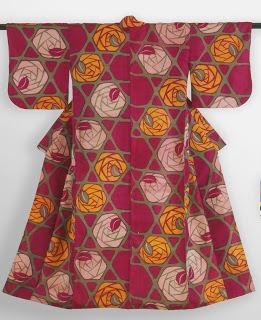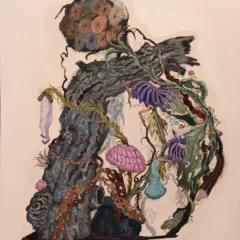
There’s a stunning new exhibition at the Philadelphia Museum of Art’s Perelman building, Fashioning Kimono; Art Deco and Modernism in Japan (through July 20, 2008). Even if clothing or things Japanese interest you not a bit the exhibition should appeal to anyone who cares about modernism in decorative arts, textiles, decorative patterning and cross-cultural influences in material culture (the academic term for ordinary stuff). There’s even something for the WWII buff!
On entering the gallery, which is curtained to protect the kimonos from natural light, you’ll see the women’s kimonos arrayed around the periphery, sleeve-to-sleeve, looking like huge butterflies pinned to a collector’s case. A small plinth in the middle of the gallery holds men’s and children’s wear and the entry wall displays a group of commercial photographic portraits of women in traditional garb, some with their families who are usually in Western clothing. Japanese women retained traditional dress longer than men and still wear it for ceremonial occasions.

Woman’s Kimono, 1920s–30s. Machine-spun silk plain weave with stencil-printed warp threads (meisen). 63 x 45.25 inches The Montgomery Collection, Lugano, Switzerland
While the very earliest kimonos retain a mostly-Japanese aesthetic, kimono fabrics have long been subject to foreign influences; the spiraling arabesques in the kimono above were imported from China in the 7th century but ultimately derive from ancient Egypt. The focus of the exhibition are kimonos whose fabrics appropriate a range of Western styles and occasionally subjects. Some reflect the round-trip influence of Japonisme upon the Japanese (Japonisme is the term for the Western incorporation of Japanese aesthetics, a particularly significant influence in Art Nouveau fine and decorative arts and also seen in the work of other 19th century artists including Degas, Toulouse Lautrec, Gauguin and Whistler as well as numerous writers, dramatists and musicians); this re-appropriation is rather like Afro-pop which adapts American popular music that itself draws on African rhythms.

Woman’s Kimono, 1920s–30s. Machine-spun silk plain weave with stencil-printed warp and weft threads. 61.25 x 43.25 inches. The Montgomery Collection, Lugano, Switzerland.
Kimonos are invariant in design, consisting of long, flat panels of fabric, so the textiles are all that distinguish one from another – they make the garment, and the Japanese have a great textile tradition. They are also among the world’s supreme decorators and the exhibition shows that they can make patterns out of any motif, not just the traditional cranes, swallows, chrysanthemums and bamboo but, books, cars, trains, tanks and the Empire State Building (no kidding). If you think of Japanese taste as one of restraint, think again! There are patterns here that would have looked bold in the 60s.

Woman’s Kimono, 1930s–40s. Machine-spun silk plain weave with stencil-printed warp and weft threads. 57.5 x 49.25 inches. The Montgomery Collection, Lugano, Switzerland.
I don’t know why the books on an orange kimono would have been chosen (and they are codex format, which was a Western import), but some of the motifs emphasize modernity such as the speeding train and up-to-date car printed on a boy’s kimono, as well as patriotic concerns. Another boy’s kimono depicted battleships, tanks and bomber planes set against the image of Mt. Fuji; the design is so detailed that the planes have been identified as Mitsubishi Ki-2-1s.









